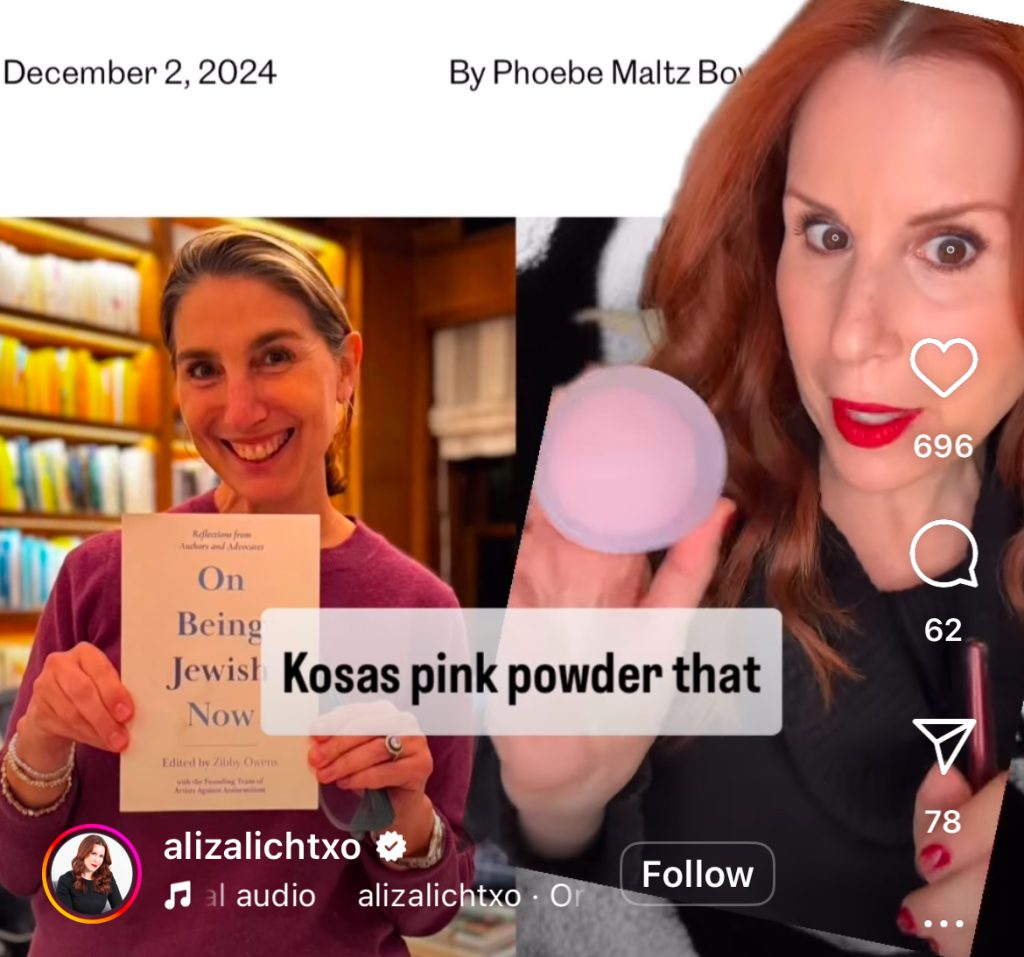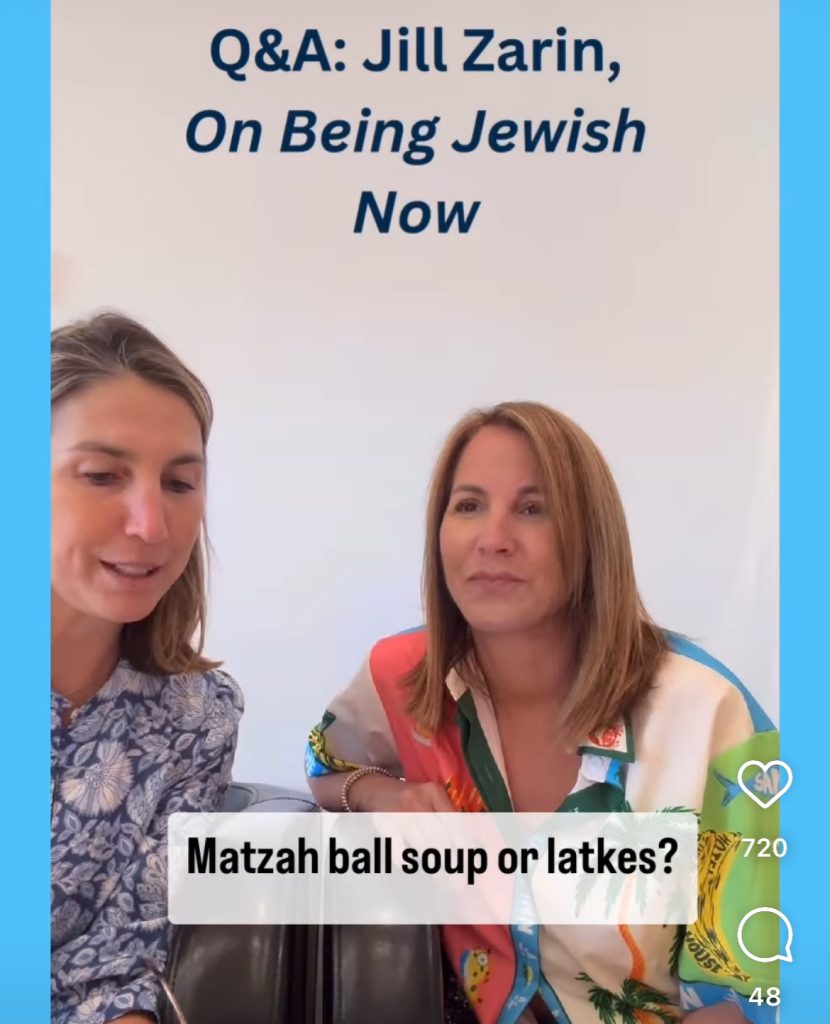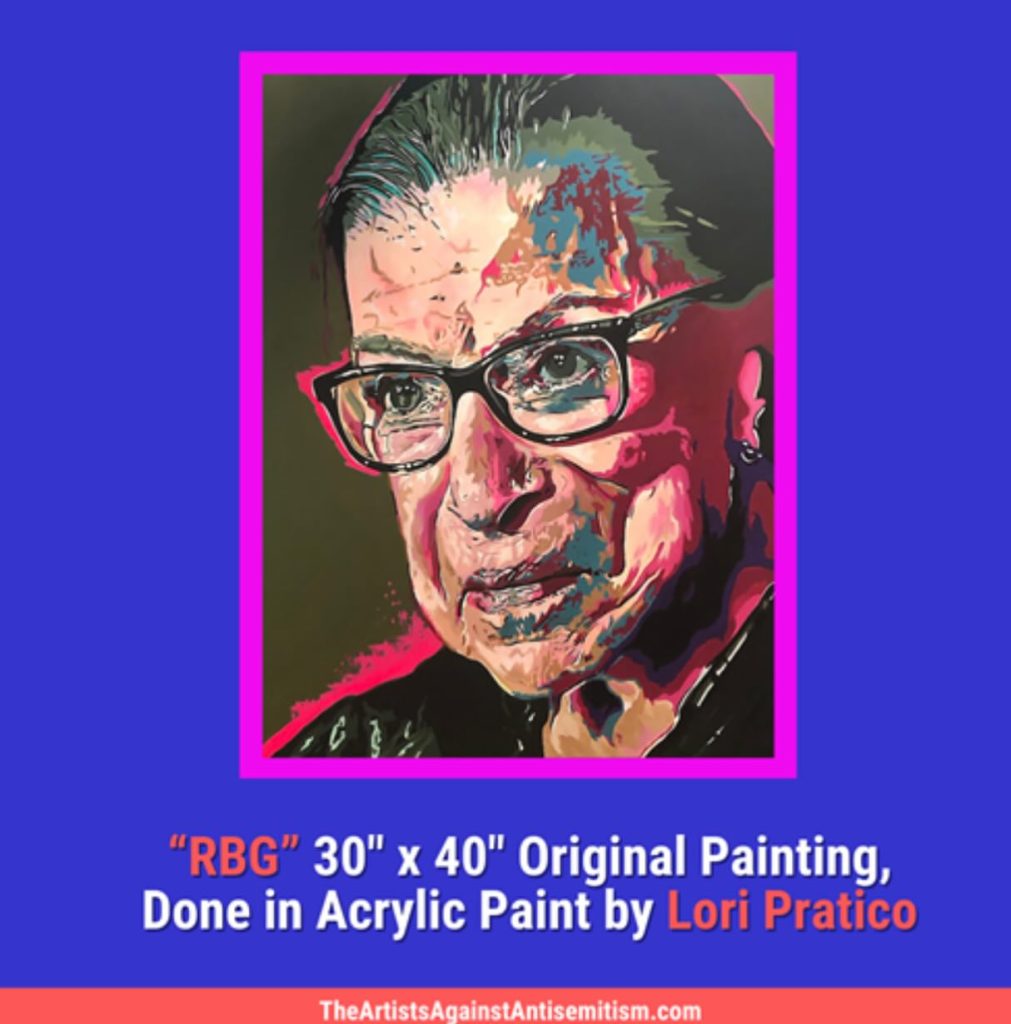Perhaps the woman behind the book On Being Jewish Now is a bit like Philip Roth after all.
It was a whole lot easier to be a post-parochialism Jew prior to Oct. 7. Zibby Owens, a leading American bookfluencer—and author, and publisher, and more—had not “disproportionately” sought out Jewish books. So she explains in the introduction to the anthology she just edited, which she is promoting this week in Toronto with an event featuring Indigo CEO Heather Reisman.
Back then, as far as Owens was concerned, “A book was a book was a book.”
And then Oct. 7 happened and she was moved to action. She edited an anthology which benefits a non-profit she started, Artists Against Antisemitism. I say Owens did this but there are teams credited alongside. This is a group effort. There is staff. It is a book. It is also, in a sense, a fundraising pamphlet that happens to exist in book form, which means that to review it is also to take that into account. This is more complicated than you might think.
I like to do book reviews with an open mind. If you’re someone I have a close personal relationship with or, conversely, had some kind of falling out with (though no one is coming to mind for the latter), I’m not reviewing your book. But I’m not a robot, and will often have a pre-existing conception of an author and their work. Maybe I like their writing generally, or don’t. Maybe we’ve had nice interactions online, maybe less-nice. But I will just pick the thing up and see what it is.
This was put to the test by my having already angered one contributor to On Being Jewish Now enough that I received the first-to-my-knowledge video-format criticism of something I’d written. Or at least the only one that included a face-powder-application interlude before cutting to the chase.

It was bad form, you see, to write a book review of a book I hadn’t even read. I suppose it would have been… which is why I did nothing of the kind. I do review books for The Canadian Jewish News, plenty of ‘em, but that essay wasn’t a book review. It was a lengthy essay about Jewish literature in which I briefly mentioned the existence of On Being Jewish Now, as a thing that exists in the world. This is an extremely normal thing to do, but tell that to Instagram.
Well. Face-powder-gate—paired with the offer of a free promotional galley—brought it right up to the top of the pile. My curiosity was piqued.
Here’s another important angle, at least I think it is: This could be a case of biases cancelling each other out, as I am, like the contributors, a Jew who’s troubled by post-Oct. 7 antisemitism, and who cares about the continued existence of Israel. I am an author and essayist (“artist” might be pushing it) with skin in the game, as well as an opinion writer and podcaster with a pretty decent track record if I may say so of covering incidents of literary antisemitism specifically. It was a bit jarring to find that I had become enemy du jour of a bunch of people with give or take my own views on the issue at hand. It had an element of, you got the wrong guy!
So, without further ado: I have read every page of On Being Jewish Now. Hadn’t then, have now. What I wrote previously was not a review of it. What follows is one—even if it may not be the kind of write-up that my powdering detractors were wishing for.
***
As the title suggests, On Being Jewish Now prompted contributors—American, for the most part—to write essays foregrounding not just the Jewish aspects of their lives, but the way this shifted after Oct. 7. There are, one presumes, Jews who felt plenty Jewish prior, and still do. Also Jews who were exclusively thinking about sports betting or nail art or differential equations in the beforetimes and who have not changed their routines. But Jewishness is now more central for many of us, in ways that are hard to articulate. The book is an effort to articulate those, and to tell Jews who feel weird at the moment that they—we—are not alone.
A lot of it was relatable: the anxieties over public pronouncements of Jewishness, ones that would not have occurred to me on Oct. 6. If my kid wore Hanukkah pyjamas on pyjama day, what would happen? (Nothing happens when my kids wear these outside, which they do, often, and in a neighbourhood pretty darn committed to the freeing of Palestine.) There is something maddening, in the sense of insanity-inducing, about anxiety that feels simultaneously founded and unfounded.
It is also about the ambiguity of Jewish visibility, for Jews who are not in observant garb. The star-of-David necklace—whether someone would or would not feel comfortable wearing one, how one feels when spotting one on someone else—figures prominently. In her essay, Rabbi Rebecca Keren Eisenstadt Jablonski mentions some Jews responding to Oct. 7 by putting up a mezuzah, others by taking theirs down. This succinctly sums up the weirdness of our moment.
A range of religious observance levels and trajectories on that front are represented, but this is not—a la the recent child-sized essay book What Jewish Looks Like—a collection that gives the impression that the typical North American Jew is member of a visible (unambiguously non-white) minority group. There are nods to geographic and racial diversity (socioeconomic, not so much; getting to this), but it is for the most part stories of Ashkenazi Jews in parts of the United States where many Jews live. This seems entirely appropriate.
It nevertheless borrows from the language of ‘woke’—“trauma” used to describe things that did not happen to you personally, Jewish joy, holding space, things of that nature. It positions Jewish literature in the same way that Palestinian literature is positioned now, and that various other groups’ literatures have at moments where their oppression was the current news story. Someone I was discussing the book with described it—not derisively, just descriptively—as right-wing, and I had to say I wasn’t sure if that’s it. It defies that kind of categorization.
A lot is about online life, both because that’s how we live now, and because of how recent lockdowns were. Former Real Housewife of New York Jill Zarin explains that she “lost about 30,000 followers” on social media for posting about antisemitism. It’s unclear how she knows this—people don’t generally send you a note when they unfollow, which is assuming we’re talking people, not bots, to begin with—but, maybe?

The aforementioned Aliza Licht’s essay, “Being a Jewish Activist Wasn’t on Brand for Me,” describes a different experience: “People warned me that I would lose followers by [posting pro-Israel and anti-antisemitism content]. I’ve more than doubled my following.” Licht, whose three-paragraph bio explains that she is, among other things, “a personal branding expert,” is, without a question, an expert on personal branding. Points for self-awareness.
On Being Jewish Now is a remarkably polished and well-packaged effort, given the time frame. But the writing quality varies tremendously. American-Israeli author Ilana Kurshan’s moving essay about a pre-school world travel game in wartime Israel sits alongside the serious-topic-addressing but not particularly insightful musings of a writer whose job is “Chief Grief Officer®,” the registered-trademark symbol a part of her title.
The essays are grouped into thematic sections, with one on humour called, “You Have to Laugh.” While I’m sure the writers therein have made people laugh elsewhere, it’s a mix of essays that don’t appear to be going for comedy (a sweet remembrance of New York Jewish garment-industry and discount-shopping of yore ends with an it-can-happen-here epiphany) and ones that gesture at Jewish-humour tropes without really landing, like a joke about observing the Sabbath “except” if “[t]here’s a sale at Bergdorf’s.”
Some of the essays themselves read like ad copy. “American Girl Dolls and Jewish Joy,” by a co-creator of the dolls ($161 USD a doll) with a 1990s Jewish theme. And it’s like, I’m not mad at the dolls, I don’t object to their existence, but I suppose I do object to the idea that to properly fight antisemitism I am to read about how wonderful they are.
The well-known writer Daphne Merkin’s description of her stance regarding the Middle East itself made sense, and is the unspoken undercurrent to many of the essays. In effect, to oppose anti-Jewish hatred locally, you don’t need to have any particular stance or comprehension level where Israel’s military actions are concerned. Being awful to Jews locally isn’t just wrong on its own, but does not make life better for Palestinians. A point that cannot be repeated enough.
***
The format is unusual in that the bios are quite lengthy (as in, a third of the essay may be its bio), and appear immediately after each one, rather than in a separate author-bios section at the end. Amy Ephron (sister of the late Nora) manages hers in two sentences, a rare exception. The ratio of bio to essay is remarkable and therefore a reviewer would be remiss to not remark on it.
The bios are not particularly connected with the On Being Jewish Now theme, apart from the fact that they are about people who are being Jewish now. Some read like longform LinkedIn profiles, including not just comprehensively detailed accolades but info like where a seasoned professional went to college.
Others involve cozy asides, often featuring rambunctious canines: “When not writing, she is making art, listening to lo-fi on vinyl, fangirling theater, and otherwise being grateful for her life with her husband, two grown daughters, and too spoiled dogs.” Or: “When not working, she enjoys playing tennis and pickleball and spending time with family and friends, including her adorable Pomeranian, Bossi.” Another “is a proud single mom to two incredible kids, one poorly trained dog, and two cats.” Another: “She lives in Westchester, New York, with her husband, four children, and two very bossy dogs.”
Having owned and loved a bossy dog, as a reader, I get it. As a book reviewer, however, I need to make sense of the function this sort of information is serving.
An un-generous read would be that this is an unpaid effort and the extended bio was a kind of compensation—a chance to self-promote, or self-indulge.
A more generous one: this is about emphasizing the humanity of Jews. See, Jews are just normal people who love their pets! (Something I would not dispute.)
The bios explain that these are not ordinary Jews but ones with standing in mainstream society. They bios say, in effect, it might feel like everyone in a position of cultural influence is posting Free Palestine, but not everyone-everyone! Look at all these bestselling authors, who are proudly Team Jews! The bios serve, collectively, as a point about American Jewish achievement.
Whatever the reason or reasons for the long and prominently placed bios, they have the effect of making what might otherwise have read like an essay collection read instead like a Rolodex.
***
On Being Jewish Now is not merely an attempt at capturing what it’s like to be Jewish these days. It’s raising money for a new non-profit, a 501(c)(3), the tax code for a type of American good-works endeavour, one with the hard-to-argue-with moniker, Artists Against Antisemitism. I spent a while on its website trying to figure out what Artists Against Antisemitism are offering, and the publicly available offerings seem primarily to consist of outbound links to other organizations and the recommendation that people read books such as David Baddiel’s Jews Don’t Count, and information on how to donate to or volunteer for Artists Against Antisemitism, as well as an auction with money going to Artists Against Antisemitism. Per the description on its own website, “The money we raise through donations goes to running our organization and developing projects like awareness-raising campaigns, resource guides, community arts projects, celebrations, etc.”
I spent a good long while on this website and could not figure out what the organization does-does, if that makes sense, so I emailed Owens to ask more about the organization’s initiatives. I got a response from Jill Santopolo, a founding member of Artists Against Antisemitism, pointing me to, among other things, a virtual (online) art gallery hosted by TheArtistsAgainstAntisemitism.com, and an Instagram-hosted (online) event promoting Jewish romance authors.
As best as I can understand, Artists Against Antisemitism thus far consists mainly in the realm of content creation and aggregation, with an awareness-raising component. It is not literary-award-allotting organization a la the Giller Prize, but rather the sort of charity that auctions off a 15-minute Zoom with Mayim Bialik or an acrylic painting of Ruth Bader Ginsburg.

Here is where a point must be made—one with uh broader applicability—about the need to look critically even at charitable endeavours whose names and missions we agree with. In some cases, this means investigating flows of funds. In this case, however, it’s about questioning whether awareness-raising initiatives have the intended impact. How has the bureaucratic apparatus established in recent years to address other forms of bigotry worked out? At a moment when other forms of DEI are coming under “scrutiny,” is extending DEI to the Jewish cause the best path forward?
I read through the handbook for bookstores looking to avoid antisemitism, and while it contains useful practical information about Jewish holidays and what to do if aggressive sorts are going to lose their minds because your bookstore dared platform A Zionist, it mostly reads like DEI but inclusive of Jews. Bookstores are asked to “Celebrate Jewish American Heritage Month in May” and then “Celebrate Jewish Book Month the month before Chanukah” and also to “Promote Jewish authors in intersectional displays (i.e. Women’s History Month).”
Along the same lines, Project Shema, an Artists Against Antisemitism-recommended—and auction-supported—“training and support organization” that was “built by progressive Jews,” operates under the assumption that bringing in educators will deprogram antisemites in a workplace or campus, and is the best use of finite resources. But it is not the role of journalists to say, well, they clearly mean well, and leave it at that.
The CJN’s opinion editor Phoebe Maltz Bovy can be reached at [email protected], not to mention @phoebebovy on Bluesky, and @bovymaltz on X. She is also on The CJN’s weekly podcast Bonjour Chai. For more opinions about Jewish culture wars, subscribe to the free Bonjour Chai newsletter on Substack.
Author

Phoebe is the opinion editor for The Canadian Jewish News and a contributor editor of The CJN's Scribe Quarterly print magazine. She is also a contributor columnist for the Globe and Mail, co-host of the podcast Feminine Chaos with Kat Rosenfield, and the author of the book The Perils of “Privilege”. Her second book, about straight women, will be published with Penguin Random House Canada. Follow her on Bluesky @phoebebovy.bsky.social and X @bovymaltz.
View all posts








